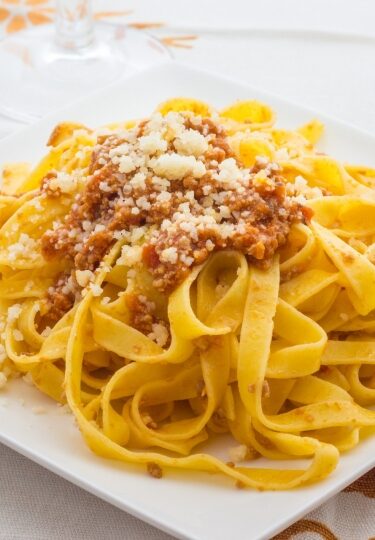While cities like Naples, Venice, and Rome vie for the title of Italy’s culinary capital, the food in Bologna marks it out as a serious challenger for the top spot.
Emilia-Romagna, the region of which Bologna is the capital, has been the agricultural heartland of the north, if not the entire peninsula, since the time of the Etruscans. The produce sourced from the overflowing breadbasket of the Po River Valley is transmuted by the Bolognese into some of the most iconic dishes in the pantheon of Italian comfort food.
Dishes of pork and animal fats and slippery ribbons of egg tagliatelle are all the better for keeping warm in a region where winters can dip below zero.
The practicality of these recipes is matched by their deliciousness, and not for nothing is Bologna nicknamed “Bologna Grossa” (“fat Bologna”). Most well known is the city’s namesake “Bolognese” sauce and plump pillows of tortellini pasta. The city has such a food fixation that what has been dubbed the world’s first food theme park, Eataly FICO, is found on the outskirts.
Here’s a short guide highlighting the most mouth-watering aspects of Bologna’s cuisine.
Tortellini
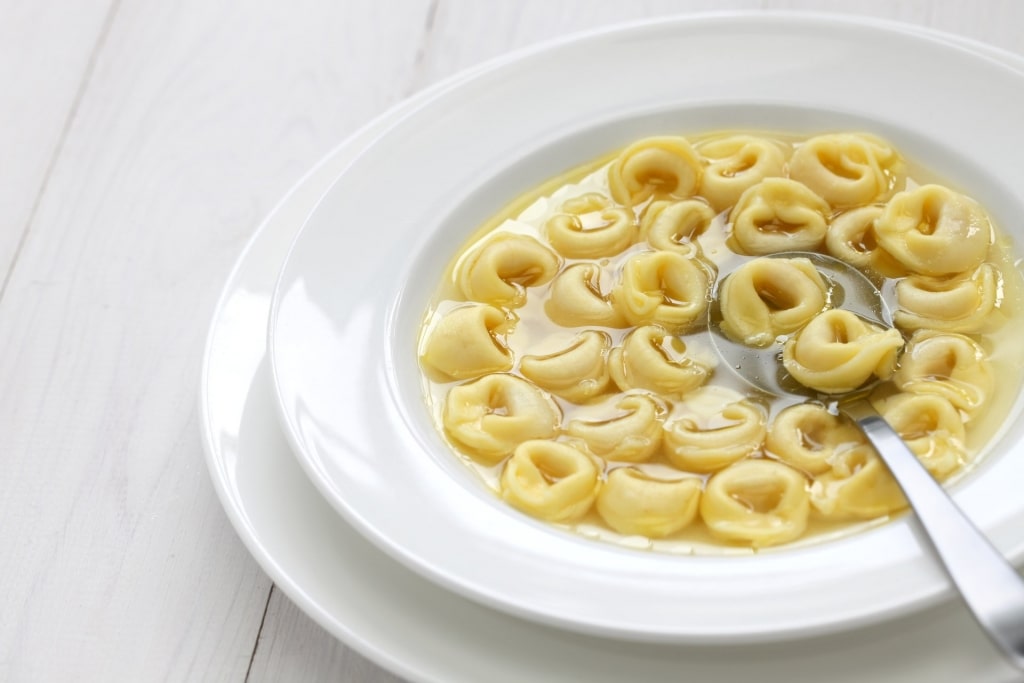
Tortellini
One of the most recognizable of Italy’s more-than-400 pasta shapes, tortellini is a stuffed pasta-dumpling that is emblematic of Bologna cuisine.
Its particular shape is attributed to a local legend that has an innkeeper peeping through a keyhole and spying the navel of Venus while she’s staying in his rooms in the town of Castelfranco Emila. The innkeeper is inspired to create tortellini in her navel’s image, and Bolognese will occasionally refer to tortellini as ombelico di Venere or “Venus’ navel”.
These dumplings are traditionally filled with a mix of meat (often prosciutto or mortadella) and sharp Parmigiano Reggiano cheese. They’re served in the hearty regional specialty of tortellini in brodo, these umami parcels bobbing in a sumptuously fragrant chicken broth.
It’s a dish often made at Christmas, throughout Italy, with the whole family pitching in to help nonna (grandma) fold up endless navels for the seasonal feast.
Mortadella
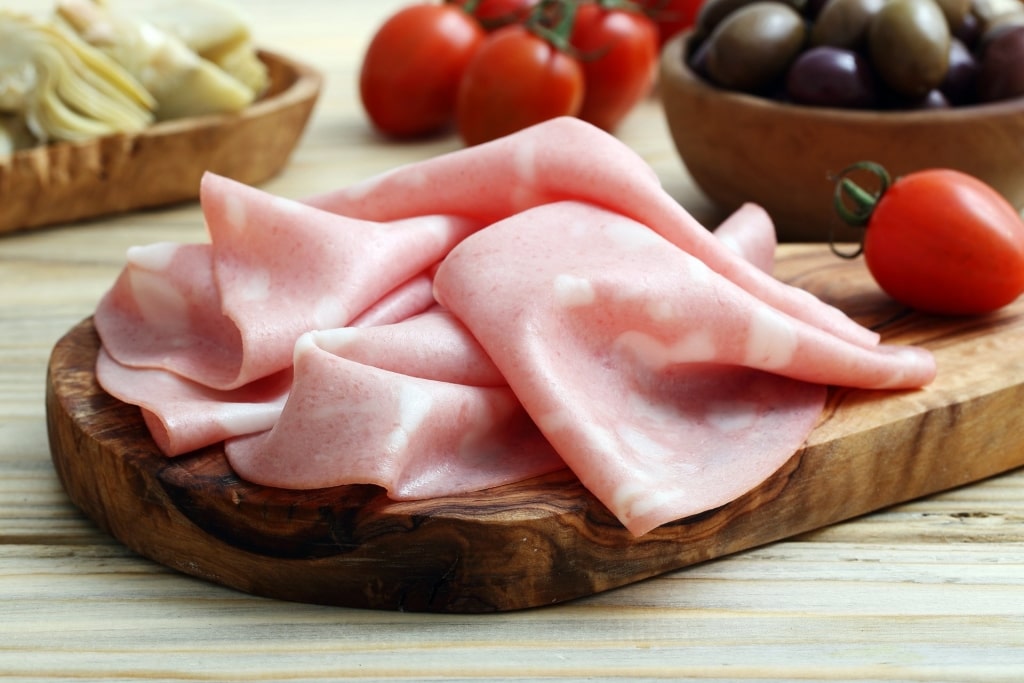
Mortadella
Mortadella is a Bolognese favorite. A sausage that predates the Romans, it’s believed that Mortadella was first concocted by those early gourmets, the Etruscans, in the 8th century BC. Its name is believed to be related to the word “mortar”, the tool originally used to mash the meat.
A cylindrical blend of cured pork, black pepper, pistachios, and myrtle berries, the inclusion of signature pork fat cubes imbues mortadella with added richness (and a loose mosaic pattern in the meat that is its visual tell-tale).
In Italy, you’ll often find mortadella sliced into silken ribbons on a salumi platter, stuffed inside melt-in-your-mouth tortellini, or sometimes rolled into meatballs to punch up the flavor with its spicy richness.
If you’re buying a whole sausage of mortadella (which can weigh in anywhere from 33 to a vast 220 pounds for the giant versions) be sure to buy “Mortadella Bologna” for the real deal.
Tagliatelle al Ragu
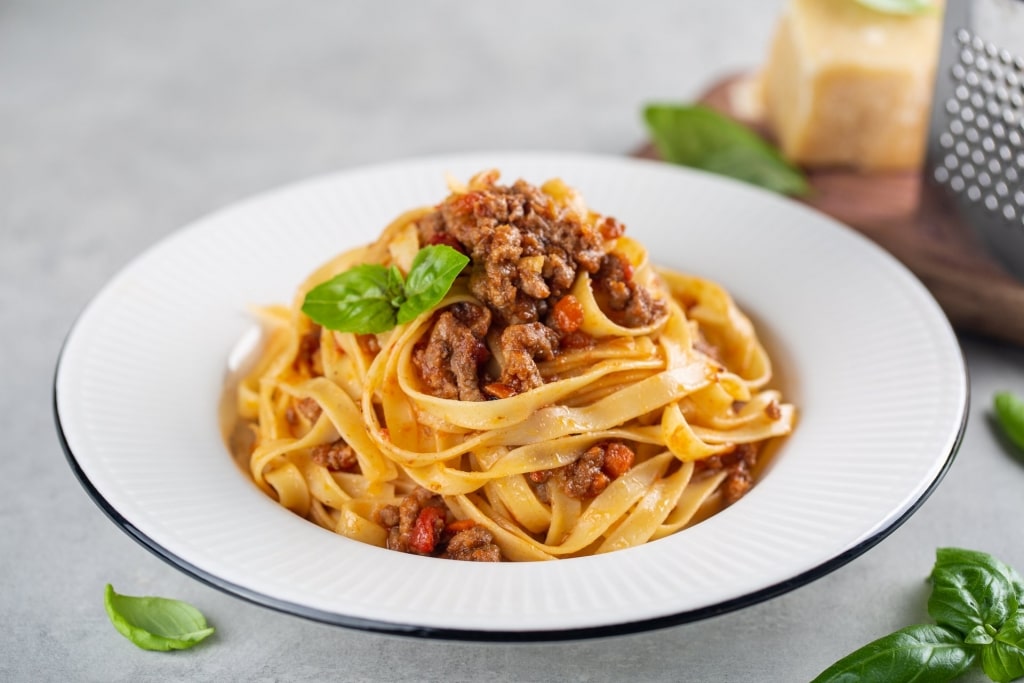
Tagliatelle al ragu
Perhaps the most visible ambassador for the food of Bologna is bolognese sauce or ragu, that single diplomat with an elusive, definitive character found in millions of kitchens throughout the western world.
For those of you eating it with parsimonious strands of spaghetti, understand that in the Bel Paese this is considered erroneous. A Bolognese (the person from Bologna rather than the sauce) would explain to you that only something like tagliatelle, with its broad ribbons of egg, flour, and salt, would successfully lick up the sauce and its rich flavors.
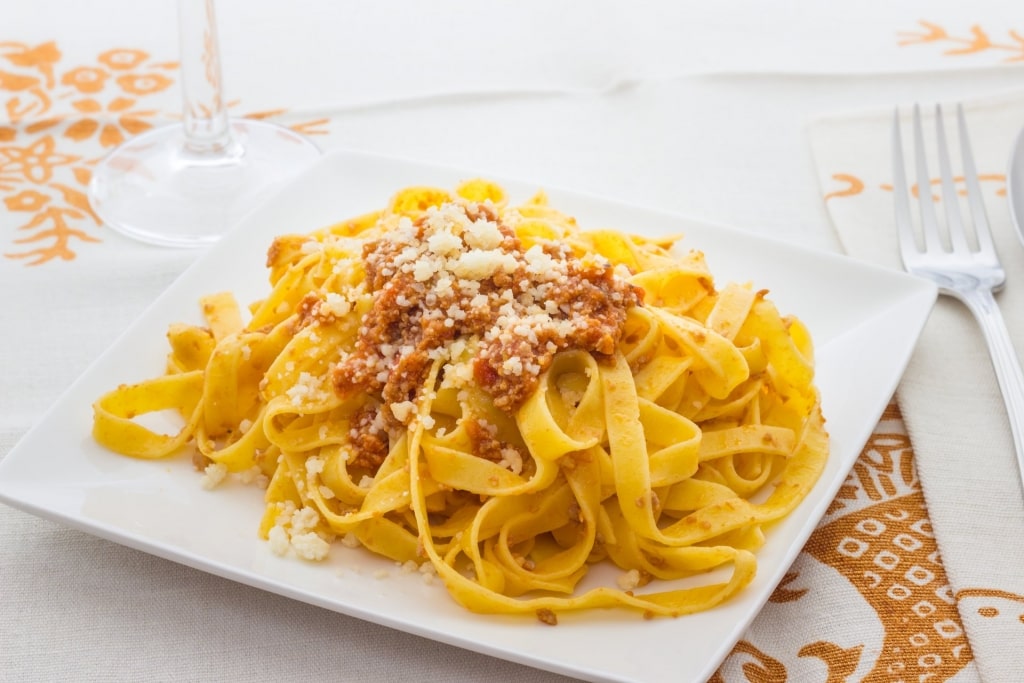
Tagliatelle al ragu
And it is this perfect union that is served in the city of its creation. The freshly-made egg tagliatelle roils in a slow-cooked sauce of minced beef (from the marbled neck portion of the chuck, ideally), unsmoked pancetta, wine, milk (to protect the meat from the acidic bite of the wine and tomatoes), onion, celery, carrot, and only a little tomato.
Finally, it’s topped with fruity Parmigiano Reggiano and, occasionally, a sprinkling of flat-leaf parsley to balance the richness.
As with much of Bologna’s cuisine, while the Bolognese are prickly about the global adulteration of their world-famous sauce, at the same time it’ll probably taste a little different wherever you decide to eat in the city.
If there’s any agreement on flavor and execution, it’s that Drogheria della Rosa, a traditional restaurant in Bologna’s historic center, has a beef tagliatelle al ragu that seems to receive universal respect.
Lasagna alla Bolognese
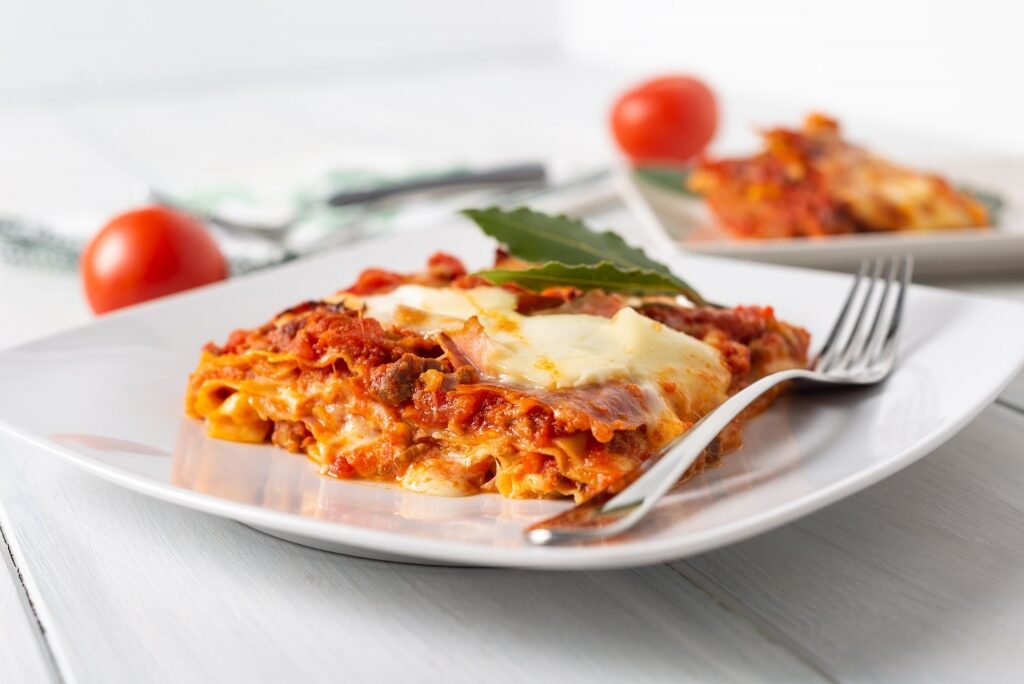
Lasagna alla bolognese
A fixture at Sunday lunches in the city, lasagna alla Bolognese is another food in Bologna that’s familiar to many from outside the region. Using traditionally made Bolognese sauce (cooked for no less than three hours), the dish becomes richer with the addition of besciamella (bechamel) sauce and grated Parmigiano Reggiano, slipped between seven sheets (a symbolic number in the Christian religion) of wafer-thin egg pasta.
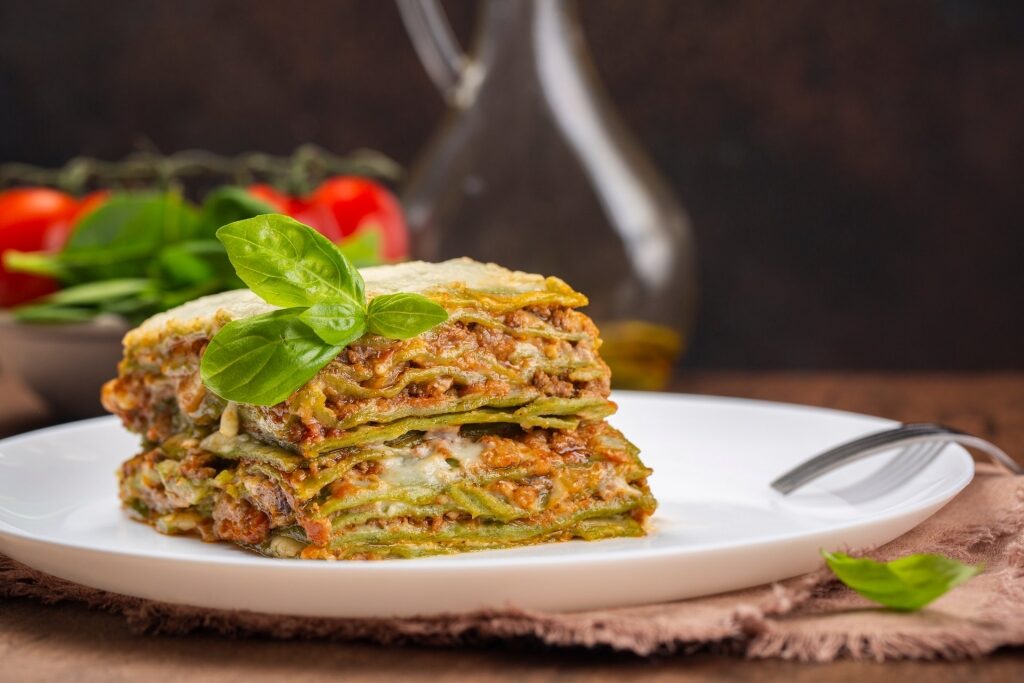
Lasagna verdi
In Bologna, most of the lasagne you’ll see will be lasagna verdi; essentially lasagna alla Bolognese except with sheets of green egg pasta (spinach adds the “verdi” color).
As with tagliatelle alla Bolognese, while many Italians may agree on the basic recipe of the dish, upon closer tasting you’ll find there are as many personal takes as there are on Twitter. Some versions include minced livers, porcini, and truffles to ramp up the sinful decadence.
Parmigiano Reggiano
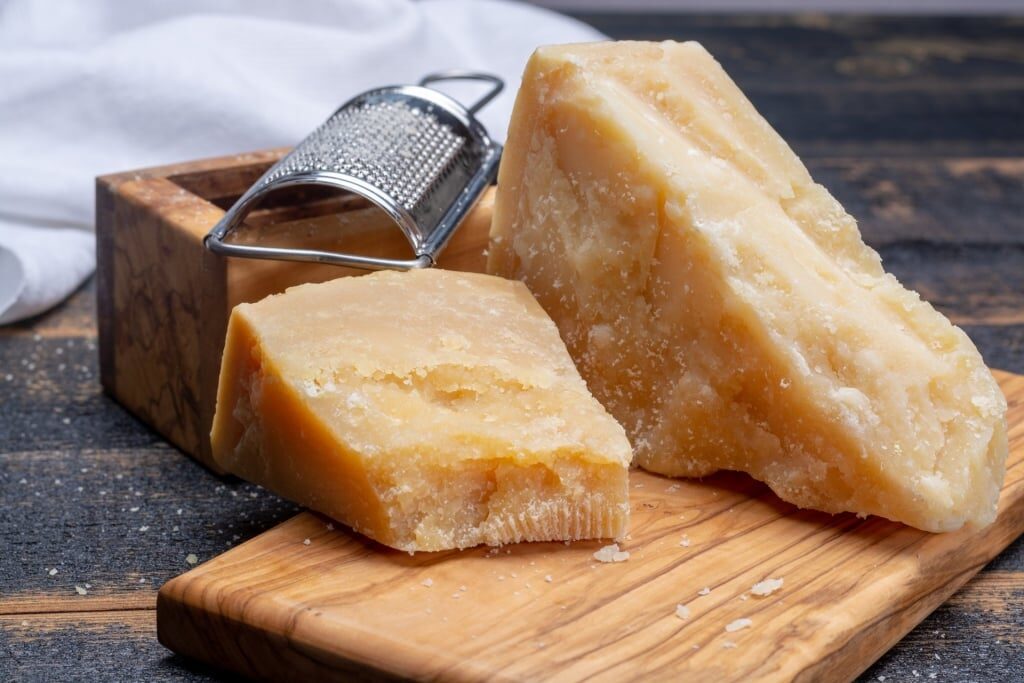
Parmigiano reggiano
This mainstay of the western refrigerator cheese compartment has remained almost unchanged since the 12th century. First created by Benedictine monks as a winter foodstuff, today, Parmesan cheese is a treasured cornerstone of Italian cuisine.
Its pineapple and caramel notes add an extra dimension to any dish over which it’s grated. You’ll also see it in crystalline chunks, drizzled with balsamic vinegar and laid out for nibbling as an antipasto.
Such a hallowed product is of course protected by a European Union protected designation of origin (PDO) dictating that Parmigiano Reggiano can only be produced in the Emilio-Romagna provinces of Parma, Mantua, Reggio Emilia, Modena, and Bologna.
The 84-pound cheeses are aged for a minimum of 12 months; only then can it be deemed “Parmigiano Reggiano”. At 36 months, the cheese has a pronounced nuttiness with flavors of allspice accompanying the fruit and a crunch of tyrosine crystals.
Tigelle
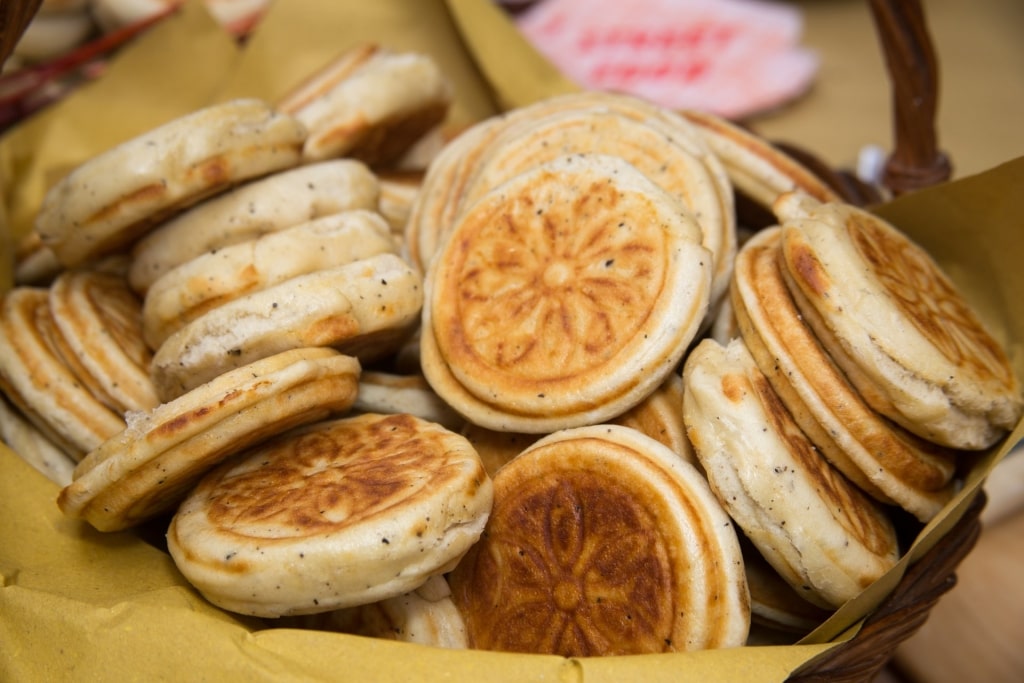
Tigelle
A favorite snack savored in Bologna’s ancient colonnaded streets, tigelle are flatbreads similar in consistency and appearance to English muffins. Tigelle were originally cooked between two circular clay tiles lined with chestnut leaves.
The tiles would be stylized so that a decorative imprint, such as flowers or a solar disc symbolizing “fruitfulness”, would be stamped on the warm, toasted exterior.
Today, progress has created the Tigelleria skillet that allows more rapid toasting with less leafy involvement, ensuring Bolognese demands for tigelles are met. After toasting, the tigelle is then sliced open and stuffed with items like prosciutto and cheese.
These snacks, also called crescentines, are often served alongside madeleine-sized fried dough pillows of gnocco fritto, another snack that’s catnip to the Bolognese.
Balsamico di Modena
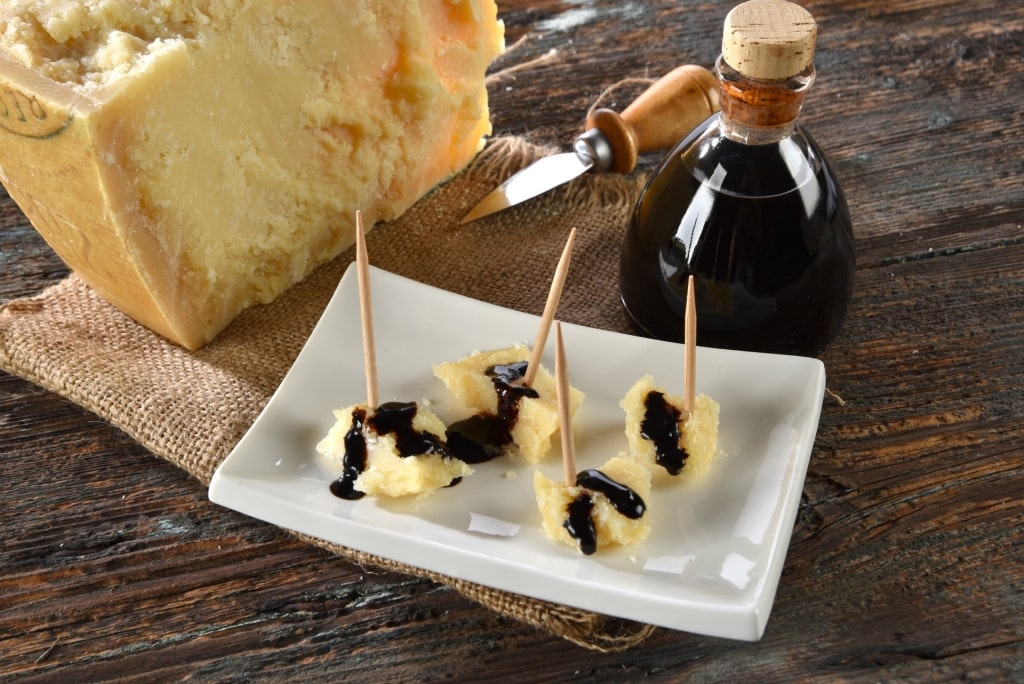
Balsamico di modena
Modena’s “black gold” is another of Emilia-Romagna’s world-beating food items. Its name stems from the word “balm”, when, in another age, it was reputed to have healing properties.
The inky black vinegar, produced from local Trebbiano grapes, may come in the cheaper, mass-produced form, with an EU PGI stamp signifying its protected geographical location. Alternatively, you’ll find the more complex liquids marked with a red seal produced through a timeworn process protected by a PDO.
The red seal denotes that this obsidian liquid within is official Modena vinegar that has been produced in the same manner as it has been for a millennium. The grapes are cooked for around 15 hours until the must (the juice, seeds, skins, and stems of the grapes, the only ingredient for the PDO vinegar) has boiled down to about two-thirds of its original mass.
The vinegar is then aged in ancient barrels that are so prized for the flavor within that if one begins to break down, a new barrel will be built around the old one rather than discard the original.
The length of aging required for the PDO is twelve years, although bottles can be acquired that have been aged for up to a century. After aging, the vinegar is blind-tasted by a consortium of sommeliers to ensure that it’s up to scratch. The flavor of good balsamic vinegar is highly complex, with a velvety texture and notes of licorice and burnt caramel that improves any food in Bologna to which it’s added.
Zuppa Inglese

Zuppa inglese
Essentially the Italian take on the classic English trifle, Zuppa Inglese is a dessert consisting of sponge fingers, custard, and plenty of alcohol. Perhaps this latter ingredient is where the name originates, with some theories suggesting that “English soup” is making fun of the British predilection for alcohol. Another suggestion is that “zuppa” is derived from the English for “sop”, which means to mop up liquid with bread.
However it acquired its misleading name, Zuppa Inglese is undeniably trifle-like in construction, flavor, and calorie count. But the application of vividly-colored Alchermes liqueur roots Zuppa Inglese in the Italian peninsula. Where, exactly, is another question.
Many regions, including neighboring Tuscany and Le Marche, have made claims on its creation but surely, with all of that excess, it must belong to “Bologna Grassa”.
Lambrusco
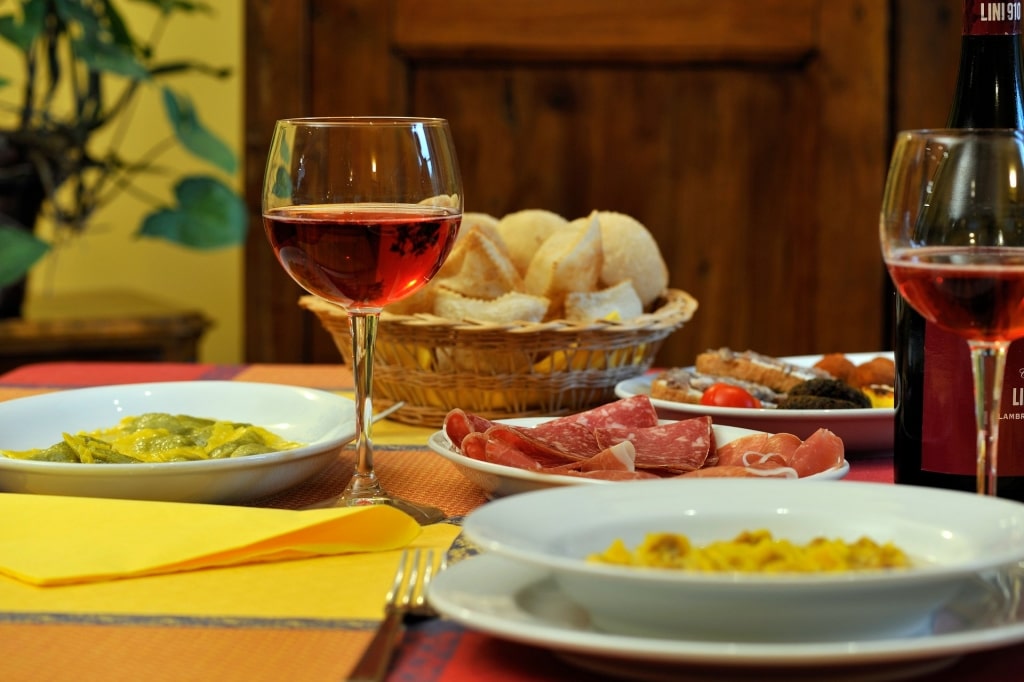
Lambrusco
A name well known throughout the world, although not always well-respected, Lambrusco captured a huge market in the West during the 1970s and 80s. During this period, Italian wine producers were focused on mass production and low quality. Lambrusco caught the imagination with its bright berry flavor, relatively low alcohol, and signature fizz.
The wine’s ignoble global reputation belies its impressive heritage in its home country. An Italian wine varietal predominantly produced in Emilio-Romagna, Lambrusco grapes are thought to have been used for vinification since the 6th century BC.
Traditionally, the vines are trained up poplar trees as a way of warding off destructive mildew. Lambrusco wine comes in a variety of styles, but its most famous iteration is the chilled “frizzante” version imbued with an effervescence after a second fermentation in a steel pressure tank.
The better versions of Lambrusco that you’ll find paired with food in Bologna can be dry, sour, and cloudy, with hints of strawberry. The wine goes down a cool, crisp treat with a board of local cheese and salumi while sitting outside a Centro Storico bar enjoying some Bolognese-watching.
Where to eat
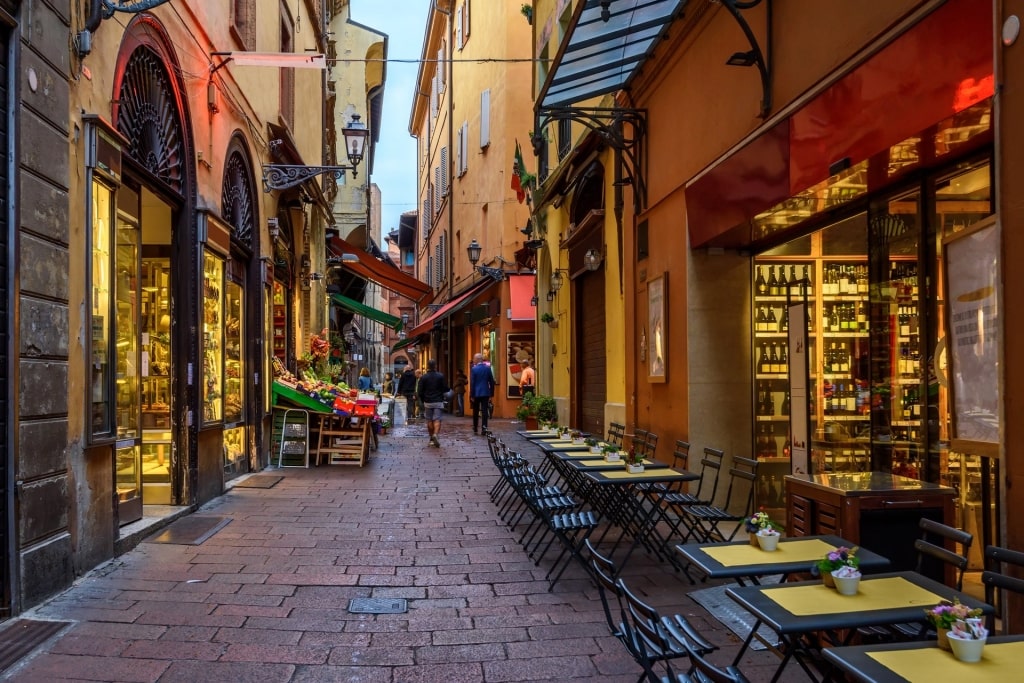
Bologna
Bologna is one of the best places to travel for food. This being the epicenter of quality Italian produce, you’ll find excellent restaurants throughout the city, from the colorful Ghetto Ebraico to the flash Colli neighborhood on the south side.
The Centro Storico (or “historic center”) has a bounty of good, more traditional restaurants to meet the expectations of the monument and museum browsers who cluster here. In the lively University District, you’ll find a greater dose of eclecticism catering to the more experimental student body.
When you eventually feel a little thirsty after admiring the Neptune Fountain and a little hungry after ascending and descending the Asinelli Tower’s many hundreds of stairs, you’ll be keen to try some of Bologna’s classic dishes executed to sigh-worthy standards.
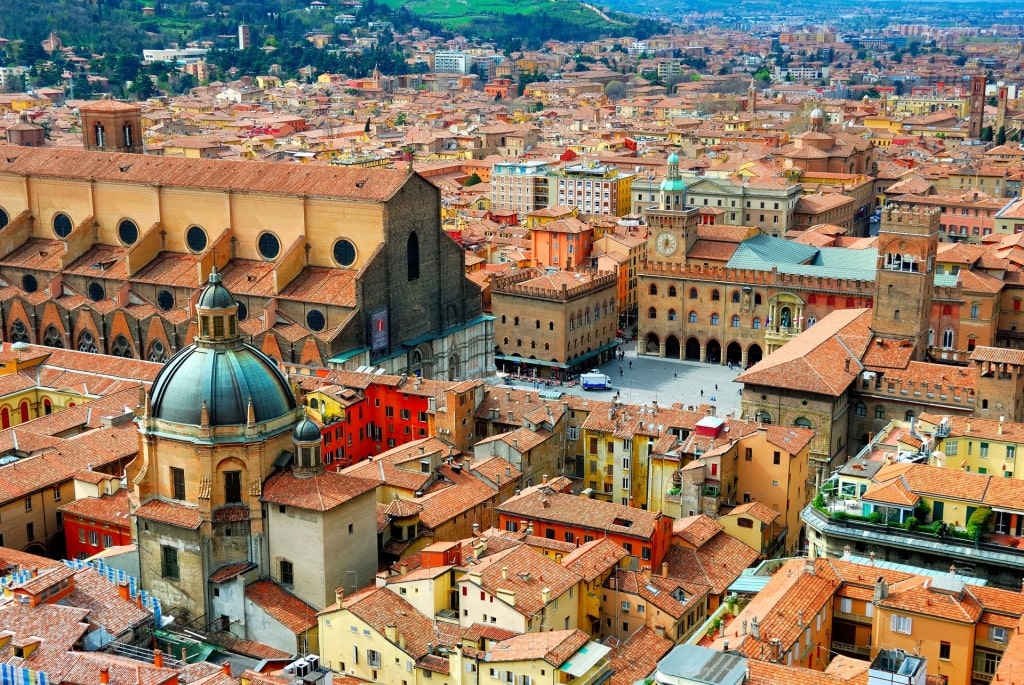
Asinelli
From the top of the Asinelli, you might have spotted (or smelled) Ristorante Ciacco, located in a former 17th-century palazzo, which prides itself on its warm welcome and being a standard-bearer for Bologna’s cuisine.
At some point in your visit, someone will recommend Cantina Bentivoglio. This traditional restaurant, located in the University District, is as renowned for its food in Bologna as its live music in this jazz-mad regional capital.
Walk a few minutes’ west of Cantina Bentivoglio and you’ll find other stalwarts such as family-run Caminetto d’Oro that will serve you up tortellini in brodo for some meditative navel gazing.
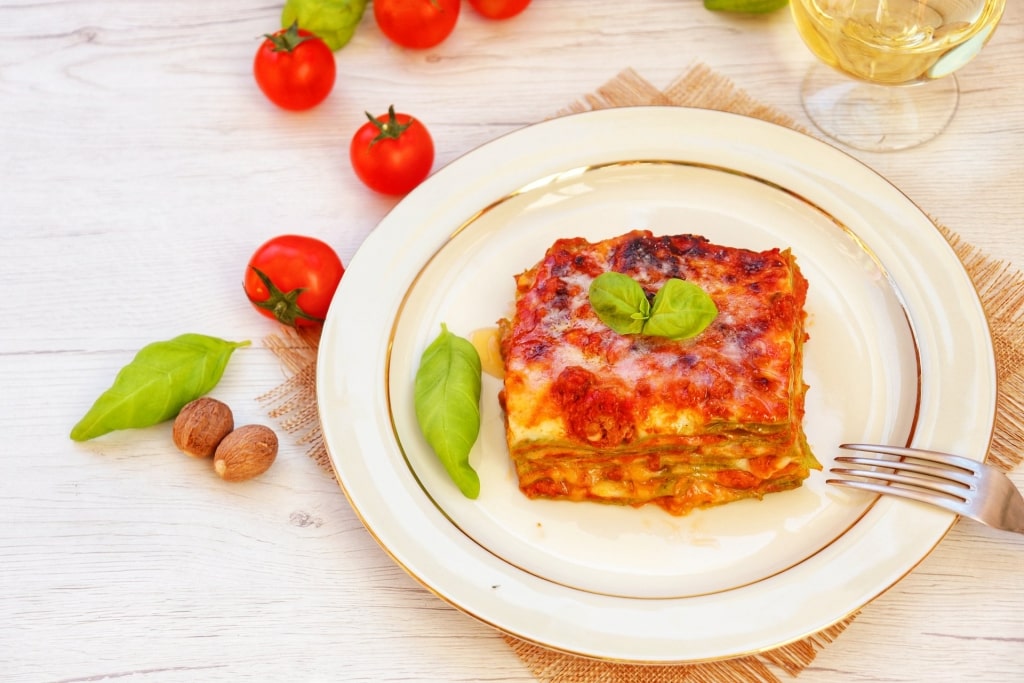
Lasagna verdi
Finally, Trattoria dal Biassanot, close to Bologna Grassa’s heaving heart, is a place revered for its lasagna verdi. Stop in for near-transparent sheets of green pasta held together by just the right amount of besciamella and ragu mortar between its sheets.
Read: Things to Do in Bologna
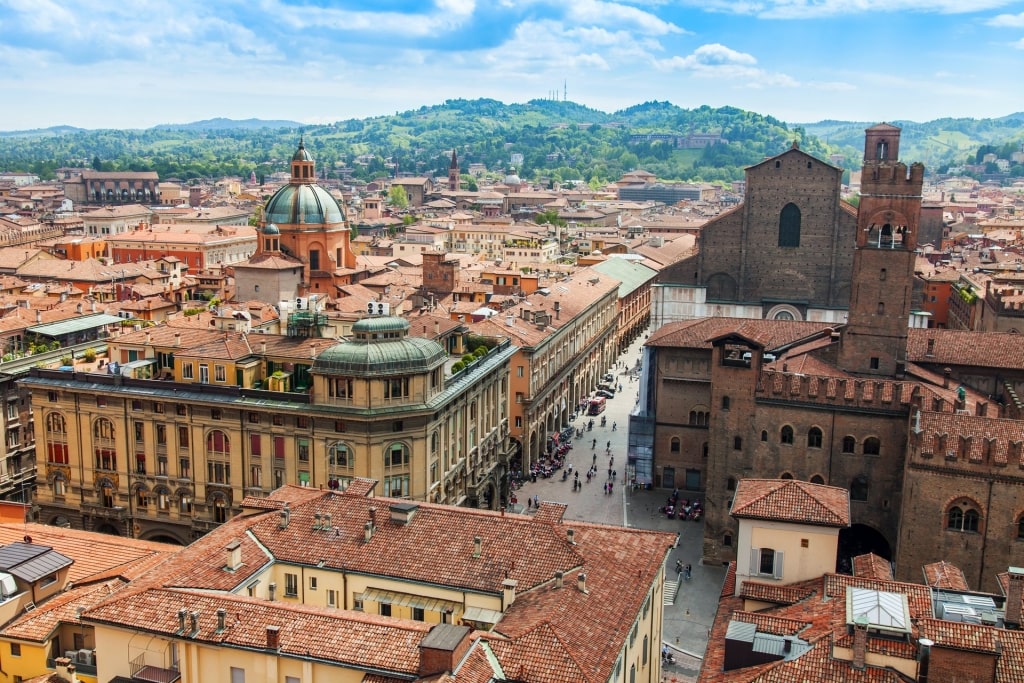
Bologna
Experience the delicious food in Bologna, as well as the city’s elegant architecture, gorgeous countryside, and immense artistic heritage on a cruise to Italy. Browse our cruise itineraries online and book a cruise vacation to this stunning country today.
